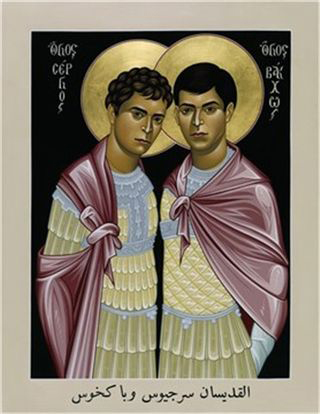A while ago on Facebook, I saw a picture of two hot young studs in uniform sitting together: happy and openly in love. Everyone loved the picture, rejoicing at the progress we've made, the liberation from the bondage of “Don't Ask Don't Tell.”

But gays serving in the military isn't exactly a newfangled development. In ancient Greece and Rome, soldiers who were also sexual partners served together, died together in battle, and in this case, were martyred for being Christian, not because they were gay. Shocking, and, as you will see, rather hypocritical, isn't it, given the polarization on the gay marriage issue still prevalent in some areas of the the United States, with the Catholic Church vowing never to change its position against any form of gay/lesbian union.
The saints' story is told in the text known as The Passion of Sergius and Bacchus. The story is ostensibly set during the reign of the emperor Galerius (305-311 A.C.E.), though the work itself may date to the mid-5th century. According to the text, Sergius and Bacchus were Roman citizens and high-ranking officers of the Roman Army, but their conversion to Christianity was discovered when they attempted to avoid accompanying a Roman official into a pagan temple.
After they refused to offer sacrifice to the god Jupiter in front of the emperor, they were publicly humiliated by being dressed in female clothing and paraded around town. Galerius then sent them to another province in the East, Mesopotomia, to be tried by Antiochus, the military commander there and an old friend of Sergius. Antiochus could not convince them to give up their faith, however Bacchus was beaten to death with whips. The next day Bacchus' spirit appeared to Sergius, encouraging him to remain strong so they could be together forever in heaven. With Jesus, definitely, but together!
Over the next few days, Sergius was also brutally tortured. Sergius refused another opportunity to offer sacrifice to the gods, and Antiochus punished him by having nails driven upright through the soles of his boots. He then forced him to run before his carriage for the nine-mile journey to the fort of Tetrapyrgium. That night, an angel healed Sergius' feet. The next morning, Antiochus was astounded at Sergius' rapid recovery and accused him of sorcery. He forced him to endure the same punishment once more, this time during the nine-mile journey to the town of Resapha. He then gave him a final chance to change his mind. But Sergius refused to do so, and Antiochus ordered him to be led away and executed.
The close friendship between the two is strongly emphasized in the stories told about them and in their cult, making them one of the most famous examples of paired or “twin” saints, like Christian versions of the famous twins Castor and Pollux in Greek mythology. The late gay historian John Boswell argues that Sergius and Bacchus's relationship contained a romantic element; he claims the oldest text of their martyrology describes them as erastai, which can be translated as "lovers". He also suggested that the two were united in a rite known as “brother-making,” oradelphopoiesis, which he argued was a type of early Christian blessing or ceremony for same-sex unions.

Now, even though Boswell's claim is still open to dispute, I would think, given that the two lived together and shared property together, were not married to women (as far as we know), and, in the course of their martyrdom, were made to dress as women in a unique way to humiliate them, these two men's true orientation is indicated. But, most significantly, they weren't being punished for being gay. If that were the case, their genitals would have been mutilated, according to one source by David Woods, “The Origin of the Cult of SS. Sergius and Bacchus.” They were being punished in that manner for being Christians!
The picture to the right is a 1994 icon of Sergius and Bacchus by the gay iconographer Robert Lentz, a member of the Catholic Franciscan order, first displayed at Chicago's Gay Pride Parade.
To read John Boswell's views on this subject, see his book, Same-Sex Unions in Pre Modern Europe.



 Join our Email List
Join our Email List Like Us on Facebook
Like Us on Facebook Instagram
Instagram Youtube
Youtube Follow Us on Twitter
Follow Us on Twitter Follow us on Pinterest
Follow us on Pinterest